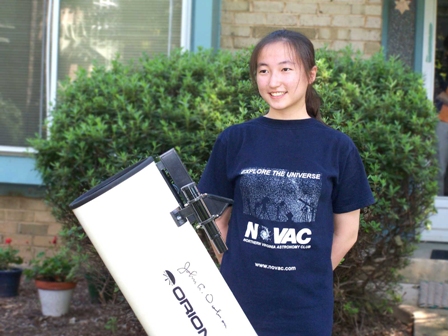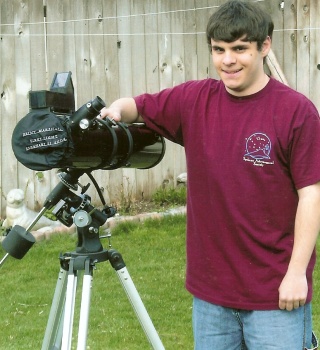The Jack Horkheimer Award for Exceptional Service by a young astronomer recognizes exceptional service by League astronomers under the age of 19. Three former presidents of the Astronomical League once again served as judges for this program. They are: Barry Beaman, Orville Brettman and Jim Fox. Thanks to these outstanding people for their continuing service to the League.
Now in its ninth year, this award is generously sponsored by Mr. Jack Horkheimer, the Star Gazer. The award is named in honor of Arthur P. Smith, Jr. Art Smith was the president of the Astronomical League from 1964-66, and he inspired Mr. Horkheimer to become active in astronomy. The first-place winner will receive a trip to the League’s 2006 convention in Dallas and a check for $1,000. All finalists receive complimentary memberships in the International Dark-Sky Association.
Also, we would like to extend our special thanks to Celestron, Inc. for providing our first-place winner with one of their company’s fine telescopes.
Spread the word among young astronomers! There are thousands of talented young astronomers across the country who are eligible to apply for this award. For an application or general information about the 2006 competition, please contact Mr.Carroll Iorg, Vice President carroll-iorg@kc.rr.com; (816) 444-4878) or refer to the League’s web page www.astroleague.org. The deadline for entries is March 31, 2007.
This year’s top finishers are:
First Place: Daniel Handlin
Daniel has been an active member of his local astronomy club, S*T*A*R, the Society for Telescopy, Astronomy and Radio, located in Monmouth County, New Jersey. He has helped schedule several of the club’s public observing events at outdoor fairs and expositions, often setting up his solar scope for supervised solar viewing by the general public. He also wrote an information sheet for the club’s public solar observing activities that has been handed out to the public for the past few years, describing the sun’s features.
Daniel has written many articles for the club’s newsletter, the Spectrogram. One of his sample newsletter articles submitted for this Horkheimer program was titled “Solar Surface Phenomena: What You’re Seeing.” He describes the physical characteristics of the sun, including the temperature of sunspots versus. the temperature of the rest of the surface (cooler); prominences; the necessity of always using proper filtering to prevent damage to the eyes when viewing the sun through astronomical equipment; and the fascination of viewing the sun with H-Alpha filters. He answers the question “What causes sunspots?” in which he points out that this phenomena results from a tangling of magnetic fields. “The magnetic field of the sun is “tangled” as the gas at the equator wraps the magnetic field lines around the sun with its quicker rotation. Regions in which the magnetic field is tangled result in sunspots. Instead of warmer gas rising and cooler gas sinking by convection, like in a coffee pot, the cool gas in a sunspot is held in place by powerful magnetic fields, over 1,000 times that of the strength of the Earth’s magnetic field. Therefore, this gas is cooler than the rest of the photosphere.”
Daniel recently lectured at his monthly club meeting on his independent research he has done while a student at High Technology High School in Lincroft, New Jersey. The topics of these two independent studies are “An Empirical Determination of the Effect of Atmospheric Drag on Orbital Decay” and “A New Observational and Data Analysis Technique for Detection, Multiband Photometric Imaging and In-Depth Analysis of Main-Belt Asteroids and Near-Earth Objects.”
For several months Daniel has been working on grinding his own 8-inch mirror for a telescope he plans to build. He is currently working on revamping the club’s website: www.starastronomy.org/.
Daniel would like to attend college at either Harvard or MIT and earn a degree in astronomy or astrophysics.
Second Place: Esther Li
 Esther is currently a junior at Thomas Jefferson High School for Science and Technology in Alexandria, Virginia. She has been interested in astronomy since she was an elementary-school student in China. She has been a member of the Northern Virginia Astronomy Club (NOVAC) for three years and has been one of the most active members in the large club.
Esther is currently a junior at Thomas Jefferson High School for Science and Technology in Alexandria, Virginia. She has been interested in astronomy since she was an elementary-school student in China. She has been a member of the Northern Virginia Astronomy Club (NOVAC) for three years and has been one of the most active members in the large club.
Ester volunteered to set up and coordinate the club’s Night Sky Network program shortly after she joined the club, when she was a freshman in high school.
She has an extensive list of public outreach activities as a club member. She has given yearly presentations to the public at Astronomy Day starting in 2004, using materials from the Night Sky Network. These presentations have been well-received by the public, with their easy-to-follow format.
She has presented materials from the online “Where are the Distant Worlds” program to her high’s school astronomy club members. She presented many “Hands On Astronomy” sessions with the public (adults as well as children), combining astronomy presentations with sessions at the telescope. Her extensive outreach effort includes numerous presentations to Girl Scout groups and school groups.
A unique outreach event mentioned in the Horkheimer application was one entitled “Women in the Wilderness,” which described a weekend women’s retreat that Ester and another club member were invited to participate in. They gave an outstanding presentation on astronomy, then gave a tour of the night sky, first with their green laser pointers, then through the eyepiece of their telescopes.
In addition to all of Esther’s other volunteer activities, she maintains one of the club’s loaner telescopes. In late August she will serve on the staff of the Almost Heaven Star Party, a major regional star party hosted by NOVAC and the Virginia Outdoor Lighting Taskforce. Esther is an active participant in her school’s astronomy club, where she has been an officer for three consecutive years. She is currently working on her Astronomical League Messier certificate.
Third Place: Brent Marshall

Brent is a junior at Lewis and Clark High School in Spokane, Washington and has been a member of the Spokane Astronomical Society for the past three years.
He received his first telescope when he was 12 and updated to a better-quality reflector a couple of years later. His favorite objects to observe are the Orion Nebula, the Hercules Cluster and Saturn and Jupiter. He is currently working on his Astronomical League’s Messier certificate.
Brent is always available to volunteer for club activities such as Astronomy Day, the annual Star Gaze public event, lunar eclipses and Night Sky Network projects. He sets up his telescope at the yearly astronomy and stargazing class sponsored by the club and the Spokane Parks and Recreation Department.
He is currently club librarian and is also youth adviser for the club’s board of directors. He has done outreach at a local elementary school, giving presentations during the regular class schedule to sixth graders. He started a small astronomy group at his school and has organized several star parties at the school.
Brent hopes to maintain astronomy as a hobby beyond high school and possibly pursue a career in the medical field or the U.S. Coast Guard.
Fourth Place: Max Peterson
Max is a member of the Delaware Astronomical Society, Wilmington, Delaware, and is a junior at Newark High School in Newark, Delaware. He is a member of the concert and marching bands.
He participated in the University of Texas McDonald Observatory Visitors Center’s volunteer program during the summer of 2005, using his own telescope during these programs. In a letter of recommendation, a member of the McDonald’s staff stated that “based on this experience, I would have no problem allowing him to run any of our facility equipment.”
Max has done astronomical presentations for his local club meetings. In addition, he has become the Power Point “guru” for the club presenters. He has competed in the astronomy competition of the State of Delaware Science Olympiad for the past two years, placing 7th this year. His interests beyond astronomy include apprenticing at a music production studio, traveling, speaking fluent German and building and maintaining computers.



